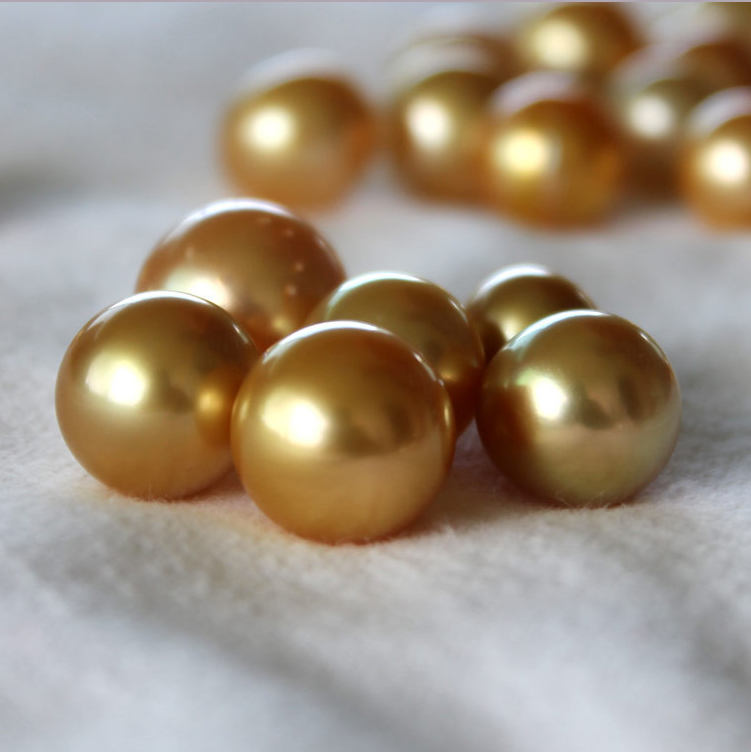With incomparable beauty and intrigue, it’s no wonder why South Sea pearls are the most valuable pearls in the world. Here are some interesting facts surrounding these gorgeous gems.
Silver-Lipped South Sea Pearls
- South Sea pearls develop from a special type of oyster called the Pinctada maxima. The largest oyster used in pearl production, the Pinctada maxima can grow to 30 centimeters and weigh over 11 pounds. Not only is the Pinctada maxima large, but so are the pearls it produces. South Sea pearls can range in size from 9mm to 20mm, with most falling between 11mm to 14mm.
- The silver lipped variety of Pinctada maxima produces 90% silver-white pearls and 10% creamy-gold pearls. The majority of these oysters can be found in the Northern Australian waters. In fact, Australia produces almost half of all white South Sea pearls grown today. These Australian pearls are typically the highest quality.
- The luster of a pearl is the most important factor when determining the value of a pearl. Silver-lipped pearls often exhibit a satiny luster that cannot be rivaled by any other pearls.
- The highest price ever paid for a strand of cultured pearls contains 23 perfect Australian South Sea pearls. The strand sold for $2.3 million at a Sotheby’s Auction in 1992.
- One of the biggest names in Australian South Sea pearls is Paspaley. In the 1950s, Nicholas Paspaley negotiated a joint venture with the Kuribayashi family of Japan to operate two South Sea pearl farms in Australia. Paspaley invested heavily in research and development to improve the quality of the pearls they produced. This led to an innovative new method of culturing pearls where all of the various stages involved in pearl cultivation could be performed on ships. Instead of building and operating on land, which is how all other pearl farms around the world operate, these ships have allowed the entire process, from gathering wild mollusks to grafting and harvesting, to be done on board. The Paspaley’s harvests represent the majority of Australia’s South Sea pearl production.
- The first stage in the pearl cultivation process is to send ship-based divers to collect wild mollusks. This occurs from February through August. The teams of divers scour the sea floor for the half-buried Pinctada maxima. The divers grab mollusks that are the appropriate size and then send them up to the surface in baskets. Because they need to dive as deep as 100 feet below sea level, the experienced divers must be careful not to advance to the surface too quickly. Doing so will increase their chances of experiencing decompression sickness and may lead to death. Divers also have to be wary of strong currents that can sweep them away. As soon as the shells are collected, they are carefully cleaned on board and transported to either land-based or ship-based pearl farms for nucleation (grafting). Nucleation typically takes place between May and September. After a minimum of two years after nucleation, a pearl is formed.
Gold-Lipped South Sea Pearls
- The gold-lipped South Sea pearl oyster produces 70-90% creamy-gold pearls and 10-30% white pearls. The mollusk only produces the golden nacre when it’s in peak condition and the environmental conditions are ideal.
- Color is the most important value factor for gold South Sea pearls. The deeper the shade of gold, the more valuable the pearl.
- South Sea pearls formed by a gold-lipped oyster can range in size anywhere from 9mm to 16mm, with most being between 10mm to 12mm.
- In the wild, only one in every 1000 South Sea pearl mollusks has the characteristics of the true gold lip, making it one of the rarest and most sought after shells.
- Like the silver-lipped South Sea oysters, the gold-lipped version is native to Northern Australia. However, they can also be found in Western Australia, the Philippines, Malaysia, and Papua New Guinea. Of these countries, the Philippines has focused primarily on cultivating the gold-lipped shell.
- Using a process of 377 steps and taking nearly five years from spat to harvest, the gold-lipped mollusks are removed from their baskets and a pearl is harvested.
Shop Kloiber Jewelers’ South Sea pearl collection here and learn more about the three other main pearl types: freshwater, akoya, and Tahitian.


